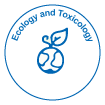Evaluating the Ecological and Toxicological Effects of Microplastic Pollution in Aquatic Ecosystems
Received: 30-Dec-2024 / Manuscript No. jety-25-161237 / Editor assigned: 02-Jan-2025 / PreQC No. jety-25-161237 / Reviewed: 18-Jan-2025 / QC No. jety-25-161237(QC) / Revised: 22-Jan-2025 / Manuscript No. jety-25-161237(R) / Published Date: 30-Jan-2025 DOI: 10.4172/jety.1000260
Abstract
Microplastic pollution has emerged as a significant environmental challenge, affecting aquatic ecosystems on a global scale. These minute plastic particles, originating from industrial, domestic, and agricultural sources, persist in water bodies, leading to detrimental effects on aquatic organisms and ecosystem dynamics. This study explores the ecological and toxicological impacts of microplastics, assessing their interactions with aquatic flora and fauna, bioaccumulation potential, and implications for biodiversity. The findings underscore the urgent need for effective mitigation strategies to reduce microplastic contamination and safeguard aquatic ecosystems
Introduction
Plastic pollution is a pervasive environmental issue, with microplastics (MPs) garnering increasing attention due to their widespread presence in marine and freshwater environments. Microplastics are defined as plastic particles smaller than 5 mm in diameter, originating from various sources, including degraded larger plastics, microbeads in personal care products, and synthetic textile fibers. The accumulation of MPs in aquatic ecosystems poses a significant threat to biodiversity, as they can be ingested by a wide range of organisms, from plankton to higher trophic levels. This article aims to assess the ecological and toxicological effects of MPs, their pathways within aquatic ecosystems, and potential mitigation approaches [1,2].
Discussion
Microplastics originate from two primary sources: primary and secondary MPs. Primary MPs are intentionally manufactured in small sizes for use in industrial applications, while secondary MPs result from the breakdown of larger plastic debris due to environmental factors such as UV radiation and mechanical abrasion. These particles enter aquatic environments through direct discharge, storm water runoff, wastewater treatment plant effluents, and atmospheric deposition. The distribution of MPs is influenced by hydrodynamic conditions, sedimentation, and biological interactions. Microplastics pose multiple ecological threats to aquatic organisms. They can alter the physical and chemical properties of water bodies, affect light penetration, and serve as vectors for contaminants. Ingestion of MPs by aquatic species can lead to reduced energy intake, impaired digestion, and false satiety. Filter-feeding organisms, such as mussels and zooplankton, are particularly vulnerable, as they can accumulate MPs in their tissues, leading to trophic transfer within food webs. Additionally, MPs can act as substrates for microbial colonization, potentially introducing pathogenic microorganisms into aquatic environments. Microplastics can exert toxicological effects due to their chemical composition and ability to adsorb pollutants from surrounding environments. Plastic additives, such as bisphenol A (BPA), phthalates, and flame retardants, can leach into aquatic systems, causing endocrine disruption, reproductive impairments, and Genotoxicity in exposed organisms. The ingestion of MPs also facilitates the bioaccumulation of persistent organic pollutants (POPs), heavy metals, and other hazardous substances, exacerbating their toxicity. Addressing microplastic pollution requires a multi-faceted approach, including improved waste management, the development of biodegradable alternatives, and stricter regulatory frameworks. Policy interventions such as bans on single-use plastics, enhanced wastewater treatment technologies, and public awareness campaigns are crucial in mitigating MP pollution. Additionally, scientific research should focus on developing innovative methodologies for detecting and quantifying MPs in aquatic environments to better inform conservation efforts [3-5].
Conclusion
Microplastic pollution is a pressing environmental concern with far-reaching ecological and toxicological consequences. The persistence and pervasiveness of MPs in aquatic ecosystems necessitate immediate action to mitigate their impact. While significant progress has been made in understanding the fate and effects of MPs, further research is essential to refine mitigation strategies and assess long-term environmental consequences. Coordinated global efforts are required to curb plastic pollution, protect aquatic biodiversity, and ensure the sustainability of marine and freshwater ecosystems.
Acknowledgment
None
Conflict of Interest
None
References
- Selvam V (2003) .Curr Sci 84: 757-765.
- Krisfalusi-Gannon J, Ali W, Dellinger K, Robertson L, Brady TE (2018).Front Mar Sci5:185.
- Arrieta MC, Arevalo A, Stiemsma L, Dimitriu P, Chico ME, et al. (2018). J Allergy Clin Immunol 142: 424-434.
- Stiemsma LT, Dimitriu PA, Thorson L, Russell S (2015). Sci Transl Med 7:152-307.
- Lorentzen HF, Benfield T, Stisen S, Rahbek C (2020) .Dan Med J67: 20-25.
,
,
, ,
, ,
,
Citation: Shenming W (2025) Evaluating the Ecological and Toxicological Effects of Microplastic Pollution in Aquatic Ecosystems. J Ecol Toxicol, 9: 260 DOI: 10.4172/jety.1000260
Copyright: 漏 2025 Shenming W. This is an open-access article distributed under the terms of the Creative Commons Attribution License, which permits unrestricted use, distribution, and reproduction in any medium, provided the original author and source are credited.
Share This Article
Recommended Journals
Open 91桃色 Journals
Article Tools
Article Usage
- Total views: 139
- [From(publication date): 0-0 - Apr 25, 2025]
- Breakdown by view type
- HTML page views: 61
- PDF downloads: 78
